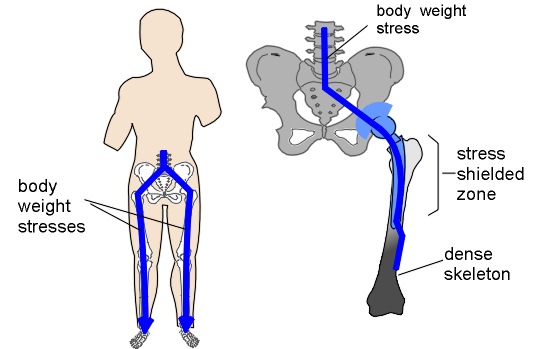
Excerpt from www.totaljoints.info
Stress shielding effect of the shaft component
"Stress shielding" – you will probably hear this term often from your surgeon and your surgeon will often hear this term from the manufacturer of the total hip device.
What is it this stress shielding? Basically, it is a mechanism that protects the skeleton from the natural stresses that the everyday life puts on it. Total hip device exerts such stress shielding effect on the skeleton around it.
We start from the beginning.
The skeleton in our bodies is loaded; the skeleton of the lower limbs sustains the load from the body weight, but not only that. The muscles attached to the long bones exert stresses on the skeleton.
The skeleton is very economical system. Where the weight load on the skeleton is large, the skeleton grows more bone tissue in the loaded area; the net result is a more closely packed and stronger skeleton that has the strength to sustain the increased load.
In areas with diminished load the skeleton retains only so much bone tissue that is necessary to sustain the diminished load. The skeleton in the unloaded areas is weaker.
A simple mechanical rule says that in every composite system composed of two materials where one component is stiffer, the stiffer component will sustain the greater part of the load.
Femoral shaft component placed within a thighbone makes such "two materials composite" where the femoral component sustains the greater part of the load.
The shaft component of a total hip device is much stiffer than the skeleton and will take the greater part of the body weight load. Consequently, the shaft component is "overloaded", whereas the skeleton around the shaft is "unloaded".

Picture: Simple scheme of stress shielding.
Left picture:
Imagine the stresses from the body weight on the lower limb skeleton as a steady flow of impulses that starts in the lower back. In the normal healthy skeleton, the stresses flow symmetrically from there downwards through both hip joints, thighbones, knee joints, lower leg bones, and feet into the floor.
Right picture:
The situation changes when there is a total hip joint device. The much stiffer shaft component of the total hip takes over the majority of the load stresses.
Now the stresses of the body weight flow through the total joint center and then through the shaft component of the device. The flow of the stresses then enters the thighbone at the tip of the femoral component. The consequences of the changed flow of stresses are two:
First, the upper part of the thighbone is unloaded; it contains less bone tissue and it is weaker, more susceptible to fracture. In the right hand picture the stress shielded area is whiter.
Second, the skeleton around the tip of the femoral component
is overloaded; it becomes more thick and stronger. In the right hand picture
this area is darker. Unfortunately, the thickening of the skeleton is often
painful. The patients with cementless shafts of total hip devices often claim
about the pain in the thigh, especially during the first years after the
surgery.
The surgeons believe that stress shielding is harmful because the weaker skeleton may fracture. The manufacturers are developing shaft components that have less "shielding effect". Because the stress shielding effect depends on the difference between the stiffness of the shaft component and the stiffness of the thighbone, the manufacturers try to produce shaft components with stiffness values more close to the stiffness of the thighbone. "Diminished shielding effect" of the femoral shaft component is one of the selling arguments of new models of total hip devices. Can one really produce artificial total hips with stiffness values that are almost identical with the stiffness of the skeleton around the total hip device?
Several studies demonstrated that this is an impossible goal.
Changing the geometrical form and the material of the femoral components, the
manufacturer may produce femoral component with stiffness that is perhaps only
twenty times greater than the stiffness of the thighbone, but the stiffness of
the component will never come really close to the stiffness of the normal
skeleton.
http://www.totaljoints.info/total_joint_home_page.htm
Copyright © HB Valdemar SURIN. All rights reserved.